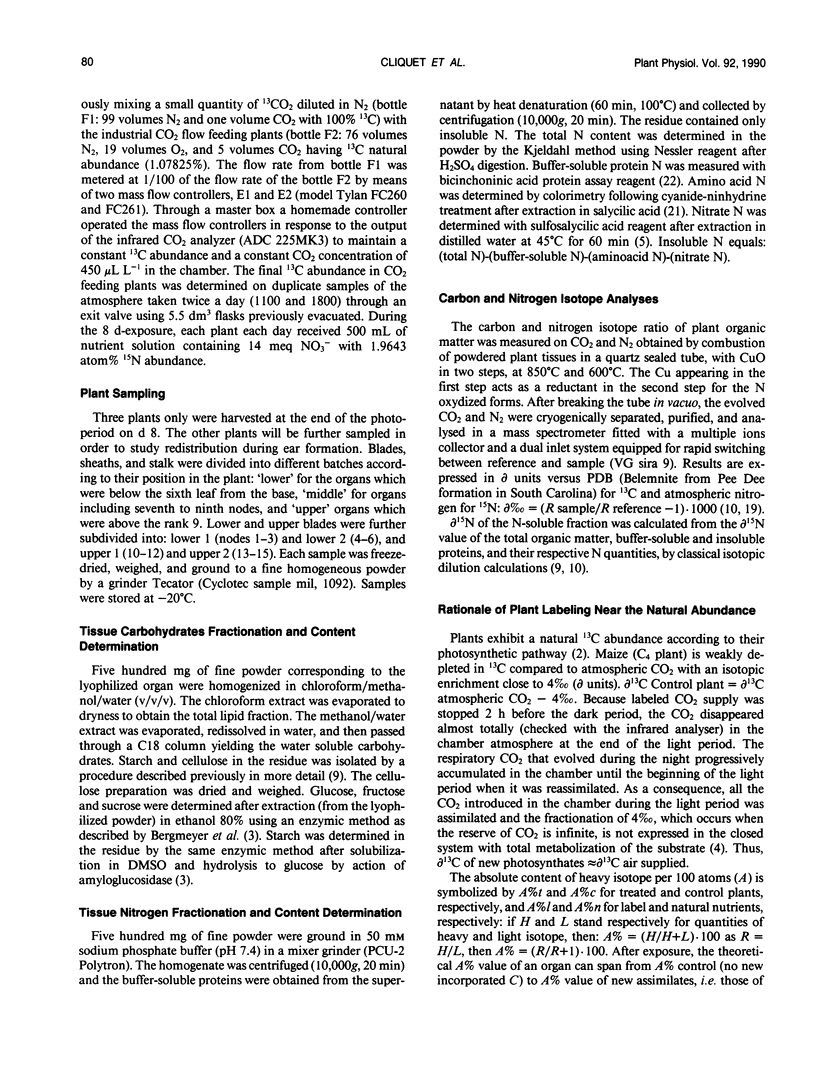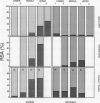Abstract
Zea mays L. (cv Dea) plants grown to the stage of stalk elongation, were allowed to assimilate 13CO2 and 15N-nitrates from 45 to 53 days after sowing. Isotopic abundances in labeled nutrients were slightly enriched compared to natural abundances. The new C in plant was acropetally distributed and the new N was preferentially accumulated in the sheath and stalk in the medium region. C input was 25-fold higher than N input. The new C in total plant C was 20%, whereas it was 10% for N. The stalk acted as a major sink because it accumulated, respectively, 27.5 and 47.5% of the C and N inputs. The new C in soluble carbohydrates was 76% in growing organs (upper stalk) and only 39% in source leaves, whereas it was 43% and 13% in starch, respectively. New N in nitrates+amino-acids spanned in the range from 20% (leaf) to 50% (stalk). New C and N in soluble proteins were, respectively, 13.4 and 3.8% in leaves, 8.8 and 9.6% in stalk, and 8.7 and 14.3% in roots. In the middle stalk and leaves, the proteins and carbohydrates represent an equivalent C and N source for remobilization.
Full text
PDF








Images in this article
Selected References
These references are in PubMed. This may not be the complete list of references from this article.
- Below F. E., Christensen L. E., Reed A. J., Hageman R. H. Availability of reduced N and carbohydrates for ear development of maize. Plant Physiol. 1981 Nov;68(5):1186–1190. doi: 10.1104/pp.68.5.1186. [DOI] [PMC free article] [PubMed] [Google Scholar]
- Cornish-Bowden A. The amino acid compositions of proteins are correlated with their molecular sizes. Biochem J. 1983 Jul 1;213(1):271–274. doi: 10.1042/bj2130271. [DOI] [PMC free article] [PubMed] [Google Scholar]
- Crawford T. W., Rendig V. V., Broadbent F. E. Sources, Fluxes, and Sinks of Nitrogen during Early Reproductive Growth of Maize (Zea mays L.). Plant Physiol. 1982 Dec;70(6):1654–1660. doi: 10.1104/pp.70.6.1654. [DOI] [PMC free article] [PubMed] [Google Scholar]
- Giaquinta R. Source and sink leaf metabolism in relation to Phloem translocation: carbon partitioning and enzymology. Plant Physiol. 1978 Mar;61(3):380–385. doi: 10.1104/pp.61.3.380. [DOI] [PMC free article] [PubMed] [Google Scholar]
- Kalt-Torres W., Kerr P. S., Usuda H., Huber S. C. Diurnal changes in maize leaf photosynthesis : I. Carbon exchange rate, assimilate export rate, and enzyme activities. Plant Physiol. 1987 Feb;83(2):283–288. doi: 10.1104/pp.83.2.283. [DOI] [PMC free article] [PubMed] [Google Scholar]
- ROSEN H. A modified ninhydrin colorimetric analysis for amino acids. Arch Biochem Biophys. 1957 Mar;67(1):10–15. doi: 10.1016/0003-9861(57)90241-2. [DOI] [PubMed] [Google Scholar]
- Setter T. L., Meller V. H. Reserve carbohydrate in maize stem : [C]glucose and [C]sucrose uptake characteristics. Plant Physiol. 1984 Jul;75(3):617–622. doi: 10.1104/pp.75.3.617. [DOI] [PMC free article] [PubMed] [Google Scholar]
- Simpson E. Measurement of Protein Degradation in Leaves of Zea mays Using [H]Acetic Anhydride and Tritiated Water. Plant Physiol. 1981 Jun;67(6):1214–1219. doi: 10.1104/pp.67.6.1214. [DOI] [PMC free article] [PubMed] [Google Scholar]
- Smith P. K., Krohn R. I., Hermanson G. T., Mallia A. K., Gartner F. H., Provenzano M. D., Fujimoto E. K., Goeke N. M., Olson B. J., Klenk D. C. Measurement of protein using bicinchoninic acid. Anal Biochem. 1985 Oct;150(1):76–85. doi: 10.1016/0003-2697(85)90442-7. [DOI] [PubMed] [Google Scholar]
- Sugiyama T., Mizuno M., Hayashi M. Partitioning of Nitrogen among Ribulose-1,5-bisphosphate Carboxylase/Oxygenase, Phosphoenolpyruvate Carboxylase, and Pyruvate Orthophosphate Dikinase as Related to Biomass Productivity in Maize Seedlings. Plant Physiol. 1984 Jul;75(3):665–669. doi: 10.1104/pp.75.3.665. [DOI] [PMC free article] [PubMed] [Google Scholar]
- Swank J. C., Below F. E., Lambert R. J., Hageman R. H. Interaction of carbon and nitrogen metabolism in the productivity of maize. Plant Physiol. 1982 Oct;70(4):1185–1190. doi: 10.1104/pp.70.4.1185. [DOI] [PMC free article] [PubMed] [Google Scholar]





